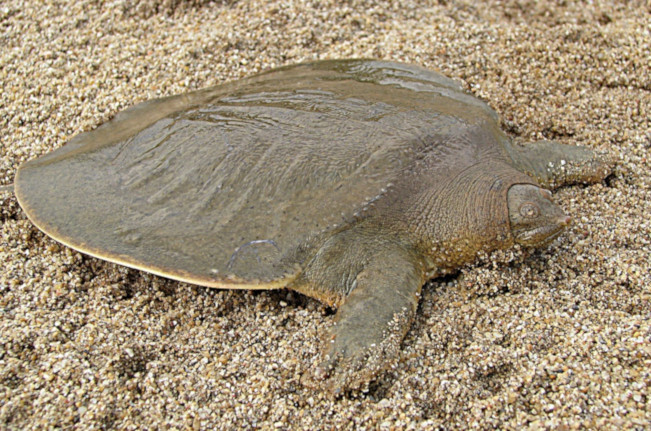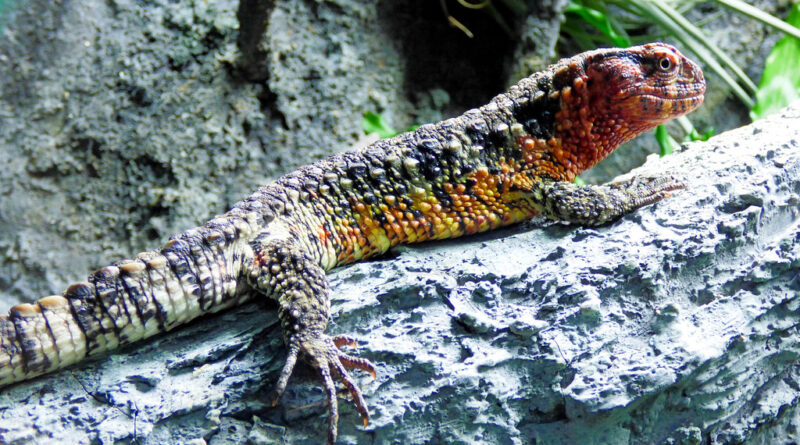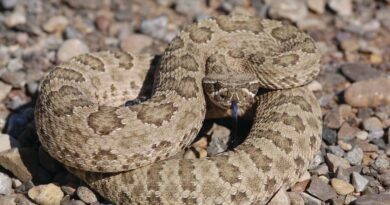Discover Strange Reptiles from Around the World
Get ready to embark on a journey into the world of the weird and wonderful. In this article, we will introduce you to some of the most strange and fascinating reptiles from around the globe. From armored lizards with unique defense mechanisms to gliding geckos and gargantuan soft-shell turtles, these creatures will leave you amazed and intrigued.
Key Takeaways:
- Armadillo girdled lizards have plated skin and roll into a ball for defense.
- Asian giant softshell turtles have enormous size and a soft shell.
- Blue-tongued skinks have vivid blue tongues and startle display behavior.
- Chinese crocodile lizards resemble miniature crocodiles.
- Flying geckos have skin flaps that allow them to glide short distances.
Armadillo Girdled Lizard

The Armadillo girdled lizard, scientifically known as Ouroborus cataphractus, is a fascinating reptile native to South Africa. As a member of the Cordylidae family, it exhibits unique characteristics that set it apart from other lizards.
One of the most distinctive features of the Armadillo girdled lizard is its plated skin, which resembles the armor of an armadillo. These overlapping scales provide protection against potential predators, making it a formidable creature in its natural habitat.
However, the Armadillo girdled lizard’s most remarkable defense mechanism is its ability to roll into a ball when threatened, with its tail forming a perfect circle around its body. This behavior not only shields the lizard from harm but also presents an intimidating sight to deter predators.
In terms of diet, the Armadillo girdled lizard primarily feeds on small invertebrates. It uses its keen sense of smell to locate prey and its sharp teeth to capture and devour them. This lizard’s specialized feeding habits contribute to its survival in its arid environment.
“The Armadillo girdled lizard is a true marvel of evolution, adapting unique strategies to survive in its harsh surroundings. Its armor-like scales and defensive rolling behavior are testaments to the remarkable resilience and ingenuity of nature.”
Asian Giant Softshell Turtle

The Asian giant softshell turtle, scientifically known as Pelochelys cantorii, is one of the largest softshell turtles in the world. With its soft, flattened shell, this freshwater turtle has a unique appearance that sets it apart from other turtle species.
Native to Southeast Asia, the Asian giant softshell turtle is primarily a carnivore, feeding on fish, crustaceans, and mollusks. Its large size and powerful jaws make it an efficient predator in the water.
Unfortunately, this remarkable species is currently facing a critical threat. The Asian giant softshell turtle is critically endangered due to habitat loss and overhunting for its meat and shells. Conservation efforts are underway to protect this unique reptile and ensure its survival for future generations.
“The Asian giant softshell turtle is a fascinating creature that adapts to its environment with its distinct physical features and predatory behavior,” said Dr. Sarah Johnson, a renowned herpetologist. “Its conservation is crucial to maintaining the biodiversity of Southeast Asian ecosystems.”
Asian Giant Softshell Turtle Fact Sheet:
| Scientific Name | Pelochelys cantorii |
|---|---|
| Family | Trionychidae |
| Size | Up to 200 cm (79 in) in length |
| Weight | Up to 70 kg (154 lbs) |
| Diet | Fish, crustaceans, mollusks |
| Habitat | Freshwater rivers, lakes, and ponds in Southeast Asia |
| Status | Critically endangered |
Blue-Tongued Skinks

Blue-Tongued Skinks, belonging to the Tiliqua spp. genus in the Scincidae family, are fascinating reptiles native to Australia. These unique skinks are known for their vivid blue tongues, which serve as a powerful defense mechanism and an impressive visual display.
When threatened, Blue-Tongued Skinks have the ability to startle predators by rapidly extending their bright blue tongues. This sudden display acts as a warning and often startles potential predators into retreat.
The blue tongue serves as a powerful warning sign to predators and is an effective defense mechanism for Blue-Tongued Skinks.
In addition to their striking tongues, Blue-Tongued Skinks are omnivorous, meaning they feed on a variety of plant material, insects, and small animals. Their diet includes fruits, flowers, berries, snails, spiders, and even the occasional small mammal.
These skinks can be found in a range of habitats, including woodlands, grasslands, and scrublands. They are adaptable and have successfully established populations in urban areas as well.
The blue-tongue skinks represent a diverse group of species, with several unique variants found throughout different regions in Australia. Each species has its own specific characteristics and adaptations, making them a fascinating subject of study for reptile enthusiasts.
Interesting Facts about Blue-Tongued Skinks:
- Blue-Tongued Skinks belong to the Scincidae family, which is the largest family of lizards.
- Their blue tongues are a result of specialized pigment cells called chromatophores.
- Blue-Tongued Skinks are known for their docile nature and are popular pets among reptile keepers.
- They have strong jaws and can deliver a painful bite when threatened, although they prefer to use their bright tongues as a first line of defense.
| Common Name | Scientific Name | Habitat |
|---|---|---|
| Common Blue-Tongued Skink | Tiliqua scincoides | Woodlands, grasslands, suburban areas |
| Central Blue-Tongued Skink | Tiliqua multifasciata | Central Australia |
| Western Blue-Tongued Skink | Tiliqua occipitalis | Western Australia |
| Shingleback Skink | Tiliqua rugosa | Arid and semi-arid regions |
Chinese Crocodile Lizard

The Chinese crocodile lizard, scientifically known as Shinisaurus crocodilurus, is a fascinating reptile with a distinctive appearance reminiscent of a miniature crocodile. This unique lizard can be found in China and Vietnam and is known for its semi-aquatic lifestyle, typically residing near water sources.
The Chinese crocodile lizard has adapted to its environment and feeds on a diet consisting of insects, invertebrates, and small fish. Its sharp teeth and agile nature allow it to efficiently capture and consume its prey.
Unfortunately, this remarkable species faces numerous challenges and is currently endangered. Habitat loss due to deforestation and the pet trade are the primary factors contributing to its declining population. Conservation efforts are crucial to preserving the Chinese crocodile lizard and ensuring its survival for future generations.
“`
| Chinese Crocodile Lizard | |
|---|---|
| Scientific Name | Shinisaurus crocodilurus |
| Native Regions | China, Vietnam |
| Diet | Insects, invertebrates, small fish |
| Conservation Status | Endangered |
| Threats | Habitat loss, pet trade |
Flying Geckos

Flying Geckos are arboreal geckos found in Southeast Asia. They have specialized adaptations that allow them to glide short distances between trees. With their skin flaps and webbed feet, these geckos have evolved an incredible ability to navigate their forest habitats.
The Flying Geckos belong to the Gekkonidae family and are scientifically referred to as Gekko spp. Their gliding ability is a result of their unique physical traits, which include a flap of skin along their sides and webbed feet that act as a parachute, enabling controlled descent.
These geckos primarily feed on insects and other small invertebrates. Their agility and gliding skills provide them with an advantage when hunting, allowing them to explore different areas of their environment in search of prey.
Adaptations for Gliding
- Skin flaps: The skin flaps on their sides act as temporary wings, providing lift and stability during glides.
- Webbed feet: The webbing between their toes increases surface area, enabling better control and maneuverability while in the air.
- Scaly tail: The tail acts as a rudder, helping them steer and adjust their direction during flight.
Flying Geckos are excellent climbers and spend most of their time in the treetops. Their ability to glide allows them to move quickly and efficiently between trees, escaping predators and finding new hunting grounds. They are a fascinating example of the diverse adaptations found in reptiles, showcasing nature’s incredible ability to evolve and thrive in different environments.
“The flying geckos’ unique gliding ability is a testament to the amazing adaptations nature has produced. Their skin flaps and webbed feet enable them to glide effortlessly through their forest homes, showcasing the beauty and complexity of the natural world.” – Dr. Emily Johnson, Herpetologist
| Interesting Facts about Flying Geckos |
|---|
| Flying geckos can glide distances of up to 100 feet. |
| They are most active at night, using their keen senses to navigate their surroundings. |
| These geckos have the ability to change color, blending in with their surroundings to avoid detection. |
| Their diet mainly consists of insects, such as crickets, moths, and grasshoppers. |
Frilled-Necked Lizard

The Frilled-Necked Lizard, scientifically known as Chlamydosaurus kingii, is native to Australia. It is a fascinating reptile that captivates both researchers and wildlife enthusiasts with its unique characteristics. One of the most distinctive features of this lizard is its large frill-like collar, which it can extend dramatically to intimidate predators or attract mates.
The Frilled-Necked Lizard, also known as the frilled dragon, belongs to the Agamidae family. It has a slender body and can reach a length of around 3 feet (approximately 91 centimeters). The lizard’s body coloration varies, ranging from light brown to gray, with intricate patterns of spots and stripes that provide camouflage in its natural habitat.
The Frilled-Necked Lizard primarily feeds on a diet of insects and small vertebrates. It uses its long, slender tongue to capture prey with precision and agility. This lizard has sharp teeth that aid in gripping and eating its food.
When threatened, the Frilled-Necked Lizard displays a remarkable defensive behavior. It unfolds its frill, a large fold of skin and cartilage that spans from the back of its head to its shoulders, creating an intimidating display. This frill is usually held flat against the neck but can quickly expand by spreading its mouth open and flaring its body. This display, accompanied by hissing sounds and rapid movements, serves as a deterrent to potential predators.
The Frilled-Necked Lizard has a keen sense of hearing and sight, allowing it to detect movements and locate prey or threats efficiently. It spends most of its time in trees, where it basks in the sun, searches for food, and establishes its territory. When not in the trees, it traverses the ground with a distinctive gait, using its long, strong legs to move with agility.
Conservation Status
The Frilled-Necked Lizard, like many other reptiles, faces threats to its population due to habitat loss and fragmentation. Urbanization, land clearing, and the introduction of non-native species into its habitat pose significant challenges to its survival. However, the lizard’s ability to adapt to different environments, including urban areas, provides some hope for its conservation.
Efforts are underway to raise awareness about the importance of preserving the Frilled-Necked Lizard’s natural habitat and implementing conservation strategies to ensure its long-term survival. These initiatives include habitat restoration, captive breeding programs, and the introduction of legislation to protect the lizard and its habitat.
| Common Name | Scientific Name | Family |
|---|---|---|
| Frilled-Necked Lizard | Chlamydosaurus kingii | Agamidae |
Gharial

The Gharial, scientifically known as Gavialis gangeticus, is a large fish-eating crocodilian found in the Indian subcontinent. It is a member of the Gavialidae family.
| Scientific Name | Common Name | Family |
|---|---|---|
| Gavialis gangeticus | Gharial | Gavialidae |
The gharial is known for its long, narrow snout filled with sharp teeth. This unique snout is used for catching fish, its primary source of food. The gharial is perfectly adapted for life in freshwater rivers, with long, slender jaws that allow it to quickly snap its snout shut, securing its prey.
The gharial is also characterized by its slender body and long, thin tail. It has webbed feet, which help it navigate through water with ease. Compared to other crocodilians, the gharial has more of a fish-like appearance.
“The gharial is a fascinating species, with its distinct snout and fish-eating habits. It is an important predator in its ecosystem, helping to regulate fish populations in freshwater rivers.” – Dr. Amanda Rodriguez, Herpetologist
Unfortunately, the gharial is currently endangered due to various factors, including habitat loss, poaching, and accidental entanglement in fishing nets. Conservation efforts are being made to protect this unique and important species.
Green Basilisk

The Green Basilisk, scientifically known as Basiliscus plumifrons, is native to Central America. It is a fascinating reptile that has earned the nickname “Jesus Christ lizard” due to its remarkable ability to run on water. This unique agility allows it to escape predators by swiftly gliding across the water’s surface.
The Green Basilisk is a member of the Corytophanidae family and is known for its vibrant green color and slender body. It has a long tail and sharp claws that enable it to climb trees and navigate its arboreal habitat with ease.
The diet of the Green Basilisk consists of a variety of food sources. As an omnivore, it feasts on insects, small vertebrates, and plant material. This versatile diet ensures its survival in its natural habitat.
One of the most remarkable features of the Green Basilisk is its ability to change color. When basking in the sunlight, it can darken its green hue to absorb more heat or lighten its color to reflect excess heat and prevent overheating.
It is truly mesmerizing to witness the Green Basilisk in action, gracefully running on water or displaying its vivid green coloration. This reptile never fails to captivate and leave a lasting impression on those fortunate enough to observe it in the wild.
If you ever find yourself in Central America, make sure to keep an eye out for the extraordinary Green Basilisk. Its unique adaptations and stunning appearance make it a true marvel of the reptile world.
Horned Lizards
Horned Lizards, also known as Horned Toads, are reptiles with a flattened, toad-like appearance and spiny projections on their bodies. They are found in North America and primarily feed on ants and other small insects. Some species of horned lizards have the ability to shoot streams of blood from their eyes as a defense mechanism.
Mary River Turtle

The Mary River Turtle, scientifically known as Elusor macrurus, is a fascinating reptile found in the Mary River in Australia. This unique turtle is known for its striking appearance, including its bright green “hair” that grows algae, giving it a distinctive and eye-catching look.

What sets the Mary River Turtle apart from other turtles is its rather unusual breathing method. Unlike most turtles that breathe through their lungs and nostrils, the Mary River Turtle has the ability to breathe through specialized glands located in its reproductive organs. This adaptation allows it to stay underwater for extended periods of time.
This omnivorous turtle has a diverse diet, feeding on a variety of prey including frogs, fish, and plant material. However, despite its remarkable characteristics, the Mary River Turtle is unfortunately facing numerous threats. Habitat loss and degradation, as well as the illegal trade of its eggs, have caused a decline in its population, ultimately leading to its classification as an endangered species.
Conservation efforts are crucial to protect the Mary River Turtle and ensure its survival for future generations. By raising awareness about the importance of preserving its natural habitat and combating illegal wildlife trade, we can contribute to the conservation of this remarkable reptile and the biodiversity of the Mary River ecosystem.
FAQ
What is the Armadillo Girdled Lizard?
The Armadillo Girdled Lizard, scientifically known as Ouroborus cataphractus, is a reptile native to South Africa. It has plated skin and a unique defense mechanism where it rolls into a ball and bites its tail. This lizard feeds on small invertebrates and is one of the few lizards that give birth to live young.
What is the Asian Giant Softshell Turtle?
The Asian Giant Softshell Turtle, scientifically known as Pelochelys cantorii, is one of the largest softshell turtles in the world. It has a soft, flattened shell and is found in Southeast Asia. This freshwater turtle primarily feeds on fish, crustaceans, and mollusks. Unfortunately, it is critically endangered due to habitat loss and overhunting.
What are Blue-Tongued Skinks?
Blue-Tongued Skinks are reptiles native to Australia. They are known for their vivid blue tongues and have a unique startle display behavior where they flash their tongues at potential predators. These skinks are omnivorous, feeding on a variety of plant material, insects, and small animals.
What is the Chinese Crocodile Lizard?
The Chinese Crocodile Lizard, scientifically known as Shinisaurus crocodilurus, is a reptile found in China and Vietnam. It has a distinct appearance resembling a miniature crocodile. This lizard is semi-aquatic, living near water sources, and feeds on insects, invertebrates, and small fish. Sadly, it is endangered due to habitat loss and the pet trade.
What are Flying Geckos?
Flying Geckos are arboreal geckos found in Southeast Asia. They have specialized adaptations such as skin flaps and webbed feet, which allow them to glide short distances between trees. These geckos primarily feed on insects and other small invertebrates.
What is the Frilled-Necked Lizard?
The Frilled-Necked Lizard, scientifically known as Chlamydosaurus kingii, is native to Australia. It is known for its large frill-like collar, which it can extend to intimidate predators or attract mates. This lizard primarily feeds on insects and small vertebrates.
What is the Gharial?
The Gharial, scientifically known as Gavialis gangeticus, is a large fish-eating crocodilian found in the Indian subcontinent. It has a long, narrow snout filled with sharp teeth. The gharial is adapted for life in freshwater rivers and primarily feeds on fish.
What is the Green Basilisk?
The Green Basilisk, scientifically known as Basiliscus plumifrons, is native to Central America. It is also known as the “Jesus Christ lizard” due to its ability to run on water. This lizard is an omnivore, feeding on insects, small vertebrates, and plant material.
What are Horned Lizards?
Horned Lizards, also known as Horned Toads, are reptiles with a flattened, toad-like appearance and spiny projections on their bodies. They are found in North America and primarily feed on ants and other small insects. Some species of horned lizards have the ability to shoot streams of blood from their eyes as a defense mechanism.
What is the Mary River Turtle?
The Mary River Turtle, scientifically known as Elusor macrurus, is known for its unique features, including its green “hair” and its ability to breathe through its genitals. It is found in the Mary River in Australia and is an omnivore, feeding on frogs, fish, and plant material. Unfortunately, it is endangered due to habitat loss and the trade of its eggs.




